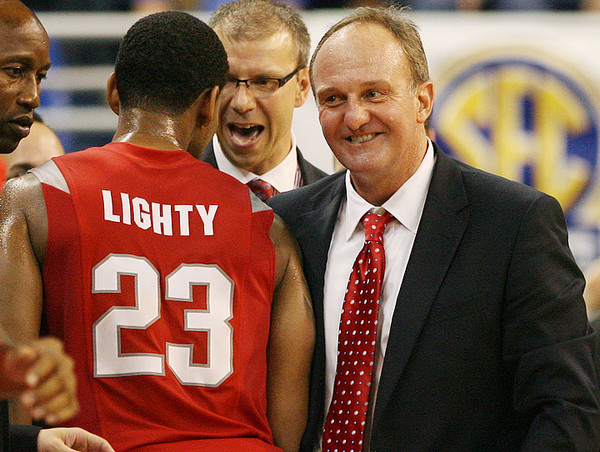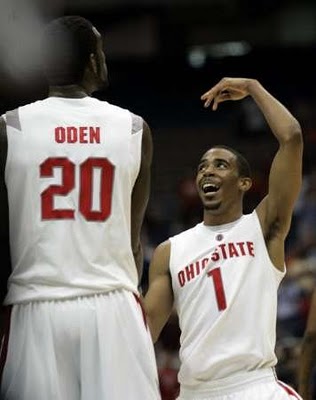Thad Matta: Great Recruiter… and Coach
Posted by Deepak Jayanti on March 28th, 2012Tom Izzo’s teams rebound the ball and play tough defense. Bo Ryan trains his players to adhere to a disciplined offensive system for every minute of the game. Matt Painter seems to be cut from the same wood as his former coach and Big Ten icon, Gene Keady. He instills confidence and toughness into his team, regardless of the talent level. Tom Crean is a dynamic recruiter and has the advantage of being at one of the blue-blood programs. Every established coach in the Big Ten has a specific brand of basketball associated with them. What about Thad Matta? What separates him from the rest?
For years, Matta was known as just a dynamic recruiter – a coach who can consistently bring in a top 25 class of freshman, most of whom would not stick around for more than a year or two in college. Nobody was surprised to see Greg Oden leave for the NBA but few expected Mike Conley and Daequan Cook to join him after just one season in Columbus. Matta recruited the likes of B.J. Mullens and Kosta Koufos, both centers who took their talents to the NBA but didn’t really pan out at the next level. Even though Matta led the 2006 class to the 2007 Final Four, the run was largely just credited to the talent on the team, not necessarily his coaching prowess. But after a second Final Four in six seasons, that image needs to change. Thad Matta is more than just a recruiter; he has shaped himself into a dynamic coach as well. Let’s examine his career at Ohio State to understand why he should be considered a complete coach in college – one who can recruit and is excellent at molding his team into a cohesive unit based on the talent available.
Matta inherited a team led by center Terence Dials, who had an array of offensive post moves but was not necessarily part of the flow in the offense, during his first season (2004-05) in Columbus. The Buckeyes were 20-12 that season but they were not an aggressive team as shown by their low free throw rate per game – only 26.4% as a team. It was either Dials scoring in the paint or wings Je’kel Foster and Ivan Harris jacking up long-range shots. But after developing his team and instilling a brand of aggressive basketball, the same group of Buckeyes showed more versatility in Matta’s second season by improving their free throw rate to 33.8% as a team. This group, led by Dials and Foster in addition to Ron Lewis, were also aggressive on the boards by improving their offensive rebounding percentage to 30.3% in 2006, almost a three percent improvement from the previous season. Significant strides in the intangible aspects of the game with the same team over one season prove Matta’s ability to improve his team’s weaknesses regardless of the talent level.
The 2006-07 squad had all the talent in the world, so it was no surprise to see Matta turn it into a Final Four run. But his coaching abilities were put to the test in 2008-09. He lacked a clear leader on the team after the talent exodus of 2007, which resulted in a trip to the NIT the next year. Matta made the necessary adjustments the following year by recognizing long and athletic Evan Turner’s talent and potential to get into the paint. Without a true point guard in his offensive sets, Matta let Turner handle the ball and be the playmaker. It is tough to judge Matta’s ability to develop players when most of them leave after one or two seasons but he has an impact on the ones that stick around for a while in his system. Turner’s game tremendously changed from his freshmen year and he developed into a top two pick in the NBA Draft. Jon Diebler learned how to weave around screens and find his shot rather than just setting up for long-range shots over his four seasons.
Kentucky’s John Calipari receives well-deserved attention for his capability of building Final Four teams consisting primarily of 18- and 19-year olds. But Thad Matta is no slouch when it comes to talent management. Over the years, Matta has shown that he can efficiently incorporate a talented freshman class along with experienced veterans without missing a step in the offense. The 2007 team couldn’t have made it to the national championship game without the leadership of Ron Lewis and Ivan Harris. Freshmen Oden and Conley meshed very well with Lewis and Harris without any issues. Last season, the highly touted freshmen class of Jared Sullinger, Aaron Craft and Deshaun Thomas learned how to play with two veteran wings, William Buford and David Lighty. Matta deserves every ounce of credit for controlling his player’s expectations and making them both understand and believe their roles within the offense. It is not easy to mix a group of talented freshmen into the offense and have the buy-in from juniors and seniors to form a cohesive team, yet Matta has proven capable.
There are several coaches in the Big Ten who struggle with managing talent and roles within their teams. They are able to recruit but not necessarily bring it together on the court. Bruce Weber recruited athletic talent such as Brandon Paul and Meyers Leonard could never figure out how to effectively use both of their talents within his offensive sets. Thad Matta on the other hand balanced Sullinger’s post moves with Diebler’s three-point range along with Buford and Lighty’s experience. Motivation and player management has been one of the main reasons behind Ohio State’s run to the Final Four this season. Matta was able to convince Thomas to be aggressive rather than just a three-point shooter. He was also able to convince Lenzelle Smith Jr. to pick his spots in the offense. Craft has offensive potential but buys into the system in his role as a defensive stopper. Buford has been patient and Matta was able to keep him motivated for one last run during his senior season.
Recruiting talent is only one aspect of the game, but managing players efficiently to translate to success is a whole different ballgame. Thad Matta has been able to accomplish that in just eight seasons, resulting in over 220 wins so far at Ohio State. At 44 years young, he is just scratching the surface of his success in the Big Ten. Izzo is the master of postseason, but Matta is slowly shaping up to be a coach that could be the face of the Big Ten in about 10 years. Two Final Fours in six seasons is not a bad start for somebody who can just recruit.













































